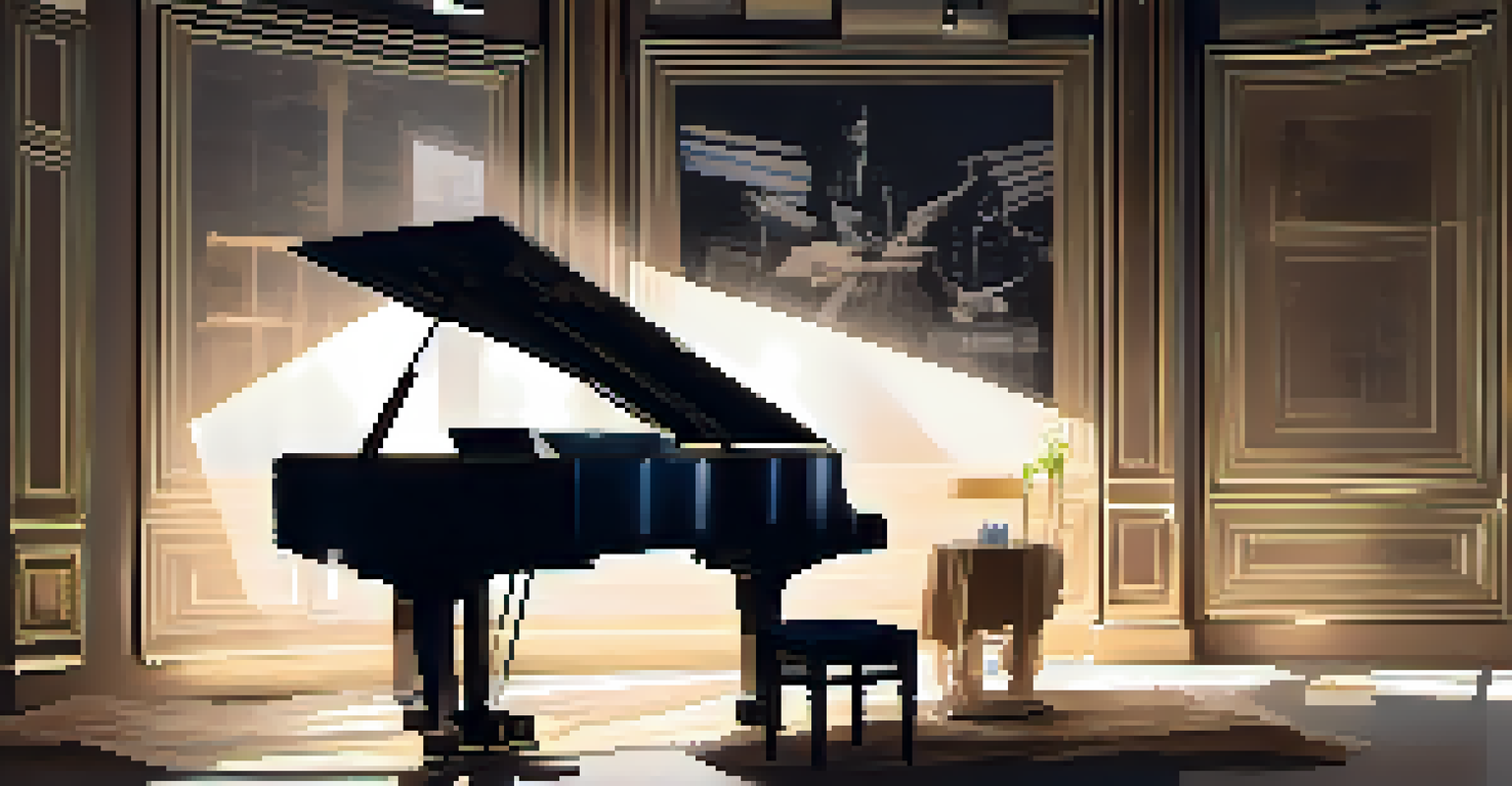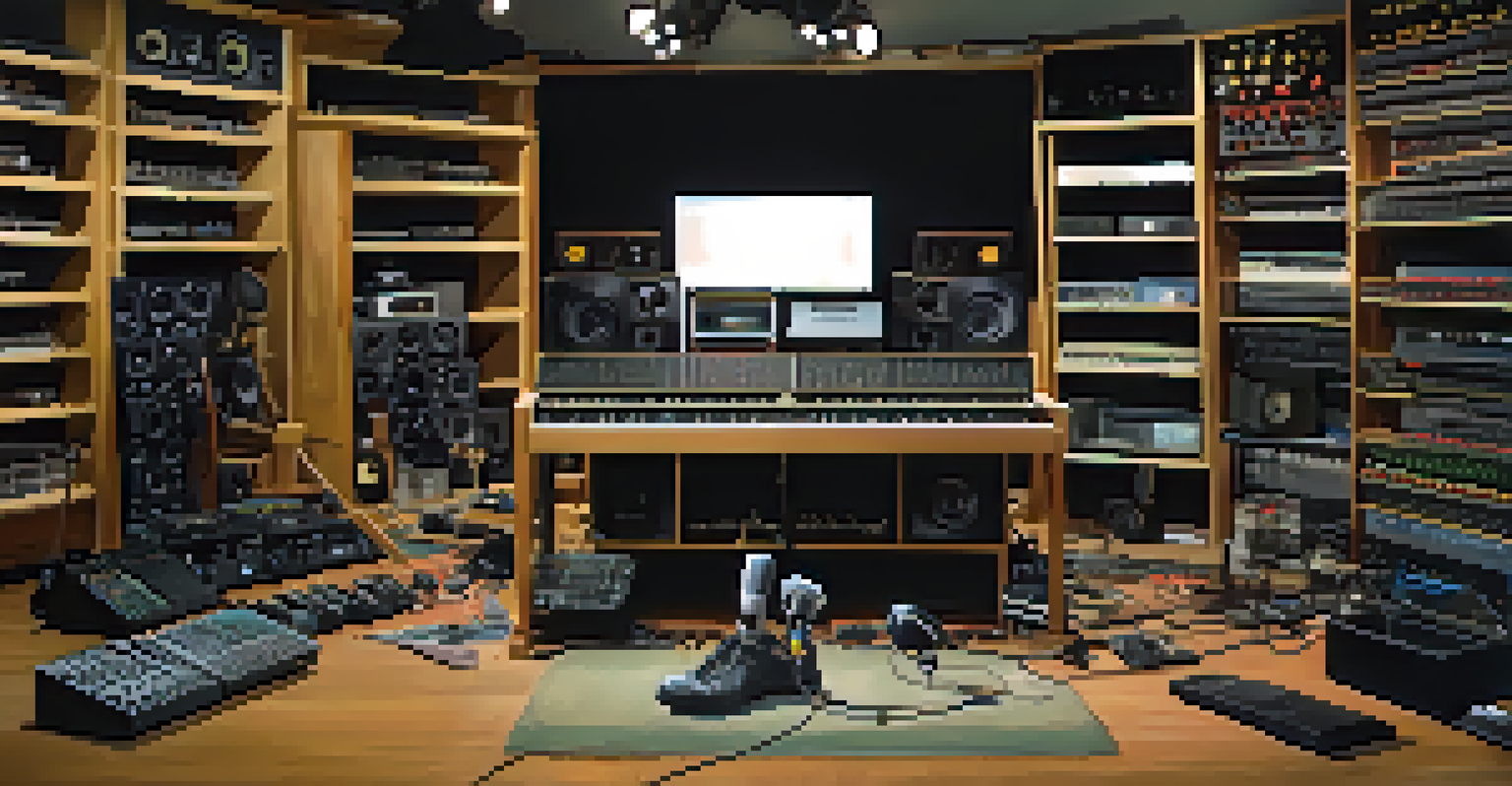Cinematic Sound: Exploring Its Role in Modern Filmmaking

Understanding the Basics of Cinematic Sound
Cinematic sound encompasses everything we hear in a film, from dialogue to sound effects and music. It's not just about filling the silence; it's about creating an immersive experience that pulls the audience into the story. Think of sound as the unseen character in a movie, enhancing emotions and guiding viewers through the narrative.
Sound is the universal language of mankind.
In modern filmmaking, sound design plays a crucial role. It goes beyond simple audio recording, incorporating layers of audio that can evoke feelings, set the pace, and even foreshadow events. For instance, the subtle sound of footsteps in a horror film can heighten tension, making viewers hold their breath in anticipation.
Moreover, sound is intricately tied to visuals; they work together to create a cohesive experience. A well-crafted soundscape can transform a mundane scene into something extraordinary, showcasing the power of auditory cues in storytelling.
The Role of Dialogue in Cinematic Impact
Dialogue is one of the most recognizable elements of cinematic sound, serving as a primary means of communication between characters. It provides essential context, reveals character motivations, and drives the plot forward. When done right, dialogue can become iconic, leaving a lasting impression on audiences.

Consider famous movie quotes; they often resonate not just because of the words, but how they are delivered. The tone, pacing, and emotional weight behind each line can elevate a scene, making it memorable. Effective dialogue can also create a sense of realism, allowing viewers to connect with characters on a deeper level.
Cinematic Sound Enhances Storytelling
Sound, from dialogue to effects and music, plays a crucial role in immersing audiences and enhancing emotional engagement in films.
However, it’s not just about what is said; it’s also about how it is said. The sound quality, including clarity and volume, affects how dialogue is perceived. Poor audio can distract from powerful lines, emphasizing the importance of professional sound design in modern filmmaking.
Harnessing Sound Effects to Enhance Storytelling
Sound effects are a filmmaker's secret weapon, adding depth and realism to scenes. They range from the subtle rustling of leaves to the dramatic explosions seen in action films. These sounds can create a vivid atmosphere, drawing viewers further into the film's world.
Music can change the world because it can change people.
For example, in a chase scene, the roar of engines and screech of tires can heighten excitement, while the sound of distant sirens adds urgency. Each sound effect is meticulously crafted to serve the narrative, ensuring that every auditory detail contributes to the overall experience.
Additionally, sound effects can also be symbolic. A creaking door might signal danger, while gentle rain sounds can evoke a sense of calm or melancholy. This layer of meaning adds another dimension to storytelling, making sound effects a vital tool in a filmmaker's arsenal.
The Power of Music in Film Narratives
Music is perhaps the most emotive element of cinematic sound, capable of stirring feelings with just a few notes. It sets the tone for scenes, underscores emotions, and even foreshadows future events. Think of how a suspenseful score can make your heart race during a tense moment.
Composers like Hans Zimmer and John Williams have mastered the art of film scoring, creating unforgettable melodies that resonate long after the credits roll. Their work highlights how music can become synonymous with a film, enhancing its identity and reinforcing themes.
Dialogue Drives Character Connection
Effective dialogue not only conveys information but also creates memorable moments that resonate with viewers emotionally.
Moreover, the strategic placement of songs can evoke nostalgia or connect viewers to a specific time and place. Whether it's an upbeat track during a montage or a haunting melody during a pivotal moment, music amplifies the emotional impact of the film.
The Art of Foley: Creating Realistic Soundscapes
Foley is the art of creating everyday sound effects that are added to films in post-production. This technique involves sound artists reproducing sounds like footsteps, rustling clothes, or breaking glass to enhance the authenticity of a scene. It’s fascinating to think about how much sound is crafted rather than captured during filming.
For instance, in a scene where a character walks through snow, the sound of crunching footsteps is often added in post-production to create the desired effect. Foley artists work tirelessly to ensure these sounds match the visuals perfectly, contributing to a seamless viewing experience.
The attention to detail in Foley work can often go unnoticed by audiences, yet it plays a crucial role in making a film feel real. When sound is done well, it becomes an invisible thread that ties the visual and auditory elements together.
The Influence of Sound Design on Audience Perception
Sound design significantly influences how audiences perceive and interpret a film. The choice of sounds, their volume, and the way they are mixed can alter the emotional tone of a scene. For instance, a soft background hum can create a sense of unease, while bright, vibrant sounds can evoke joy.
Moreover, sound can manipulate pacing and tension, guiding audience reactions. A sudden silence can be just as powerful as a loud explosion, creating a moment of suspense that keeps viewers on the edge of their seats. This strategic use of sound can lead to a more engaging cinematic experience.
Future of Sound Technology in Film
Advancements in sound technology, like Dolby Atmos and immersive audio, are revolutionizing the film experience and storytelling possibilities.
Ultimately, sound design shapes not just what we see, but how we feel. It enhances storytelling by immersing the audience in the film’s emotional landscape, making them active participants in the narrative.
Future Trends in Cinematic Sound and Technology
As technology advances, the realm of cinematic sound continues to evolve. Innovations like immersive audio formats and spatial sound are transforming how films are experienced. For example, Dolby Atmos allows sound to move freely around the audience, creating a three-dimensional auditory experience.
These advancements not only enhance realism but also open new avenues for storytelling. Filmmakers can now craft more intricate soundscapes, immersing audiences in ways that were previously unimaginable. This is particularly impactful in genres like horror and science fiction, where sound plays a critical role in creating atmosphere.

As we look to the future, the integration of virtual reality and augmented reality into filmmaking will further change the landscape of cinematic sound. The possibilities are limitless, promising exciting developments for both filmmakers and audiences alike.